Manufactured by: De Lorean Mfg. Co.
Place: Belfast, Northern Ireland
Production: 1981-82
Total Produced: 8,742
Body: stainless steel-designed by Giugiaro
Chassis: wh. base: 95 in.
Length: 168 in.
Engine: water-cooled V-6 SOHC fuel injection
Top speed: 125mph
Weight: 2,712 lbs
Suspension: Front & Rear Independent, coil springs
Transmission: automatic to rear axle
Cost new: $26-$30k
Built by John De Lorean in Belfast, Northern Ireland with British Government financing. Stainless steel panels over fiberglass, the bodies carried no paint. Of the total 8,742 produced, 4,000 were shipped to the United States. The cars were well-equipped, with standard air conditioning, leather upholstery, power windows and door locks. After bankruptcy in 1983 De Lorean was charged and acquitted by the British Government for embezzlement of company funds. 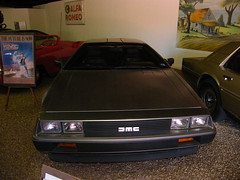
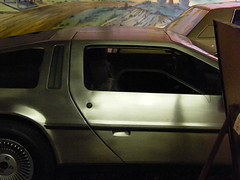
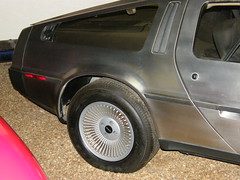
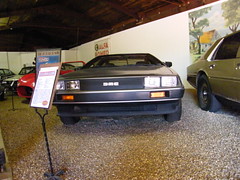
Story from OCTANE website:
DeLorean: From dream to nightmare
As we have already seen, John Z DeLorean didn’t play by the rules – and was prepared to think unconventionally in order to realise his dream of getting his gullwing sports car into production. However, choosing Northern Ireland to build his car was either the act of a genius – or commercial suicide.
When DMCL in the UK was set-up in October 1978, it was effectively a start-up operation, and the prototype had been underdeveloped.To accelerate the DMC-12’s move to production, the engineering programme at Hethel had been run simultaneously with endurance testing at the company HQ in Coventry; at a time when parallel development programmes had yet to become commonplace in the industry.
In setting up car production in Northern Ireland (as opposed to Puerto Rico), new supply deals with a myriad of component suppliers in the West Midlands needed to be set-up. This placed untold pressures on the UK managament team – and that wasn’t even accounting for the demands placed on it by setting up the green-field factory in strife-torn Northern Ireland.
Based in Dunmurry, near the Catholic Twinbrook Estate, the factory was perfectly placed to deal with the region’s rampant unemployment (it was as high as 50% in the Catholic areas). The factory was equidistant between large Catholic and Protestant estates. However, the work force wasn’t skilled, and would need training, and there simply wasn’t the industry infrastructure in place for a rapid build-up to production.
The workforce – a mixture of Protestant and Catholic – got on with the job and built the cars, proudly leaving religion at the factory gates. As for the cars – they were an object lessson in streamlined production methods. All of the components were brought in from outside suppliers apart from the fibreglass floorplan. This just-in-time construction also predicted subsequent industry practice.
Adding to the enormity of the task of getting production off the ground, John Z had set an impossible schedule. He’d promised the government that pilot build cars would be ready by May 1980, and a year after that, the factory would be assembling 30,000 cars per year. Despite this, John Z remained in New York, relying on his UK deputies – industry heavyweights such as Barrie Wills (purchasing director) and ex-GM man Chuck Bennington (product planning director) to get the operation running in the UK.
On January 21, 1981, eight months late and £34m over budget, the first DMC-12 rolled off the line at Dunmurry. Given the timetable, this was a remarkable achievement, even if the press gleefully reported the overspend of taxpayers’ money. It was still a rush job – the car was released to the public undercooked and lacking in build quality. Within months the factory had these issues licked...
The initial road tests were kind, though – after comparing it with the Porsche 911 and Ferrari 308 among others, Car & Driver concluded, ‘If De Lorean keeps it up, he could be the only North American besides Henry Ford to leave his mark and his name on the business.’ Given it cost ,600 compared with ,258 for the considerably faster (if much less refined) Chevrolet Corvette, it was an optimistic view, gullwing doors or not.
The chassis was impressive, even if the excessive ride height did its best to upset the overall levels of roadholding. Autocar reckoned it was biased towards understeer; Road and Track thought it rolled too much – and all thought it lacked the ultimate delicacy of its European rivals. But who really cared when it looked so striking?
Car & Driver summed in a wonderfully overblown way: ‘Let the sun blaze or the night lights sparkle and the sheen shines. And when the gullwings reach for the sky and their amber warning lights alert the neighbourhood’s low-flying Learjets to a new obstacle, all the world’s air traffic controllers couldn’t channel the glut of instant onlookers.’ Quite.
Despite promising early sales, the queue of buyers had evaporated by end of year – the chill wind of recession had struck the US automotive sector, and stockpiles of unsold cars started to mount up, both in Dunmurry and dockside in the USA. The worst US winter in 50 years also didn’t help the demand for sports cars.
As DeLorean had built the company on fragile finances, there was no way DMC could weather the storm. John Z desperately tried to secure additional funding from any sources available to him, while successfully managing to top up his investment from the Conservative government.
In January 1982, production was slashed and plans were accelerated to give the DMC-12 Euro Type Approval – something that John Z originally thought wouldn’t be necessary. An emergency recovery programme headed by Barrie Wills was instigated – but it was already too late.
On February 19, the receivers were called in, and after forming DMC (1982) Ltd, continued funding limited car production while a viable rescue plan was devised. The deadline would be July 31 – John Z assumed the date would come and go, and the government would offer a bailout.
DeLorean’s head of marketing, Tom Ronayne, toured Europe sounding out potential sales outlets. The feedback from over the channel was positive – and a rescue bid was cooked up. The immediate issue was to increase demand and and start selling stockpiled cars, but beyond that, Barrie Wills’ management team did all they could to make DeLorean – as a marque – saleable.
Wills and Bennington drew up a business plan that looked solid enough for them to receive a commitment to funding from a consortium of financial backers keen to rescue DeLorean.
However, on October 19, after a four-month operation, the FBI pounced on John Z in a Los Angeles hotel room for ‘narcotics violations.’ The dream came apart the moment the briefcase full of cocaine was captured on camera.
Four days later, it was over for Wills and Bennington, too. Time and money ran out, and the receivers were forced to close the company. After a run of less than two years and around 9500 cars, Barrie Wills locked the factory gates at Dunmurry for the very last time.
Did the DMC-12 deserve such a fate? Clearly, it was launched at the wrong time, was overpriced, and the company wasn’t strong enough to survive the economic downturn. However, the DMC-12 is a fascinating monument to the unique character of its creator – had anyone else attempted to build the car, it would never have made it off the drawing board. British taxpayers who stumped up the cash may have seen it differently, but John Z’s dream car deserved so much more.
Monday, May 4, 2009
1981 DeLorean Gullwing
Labels:
DeLorean,
florida,
photography,
Sarasota,
Sarasota Classic Car Museum,
Sports Cars,
travel
Subscribe to:
Post Comments (Atom)

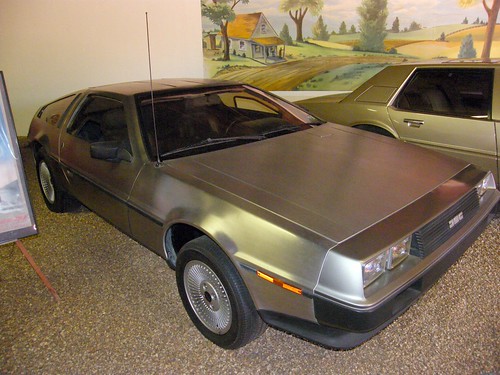




No comments:
Post a Comment